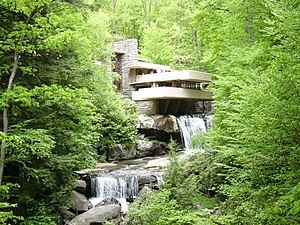Organic architecture

Organic architecture is a philosophy of architecture which promotes harmony between human habitation and the natural world through design approaches so sympathetic and well integrated with its site that buildings, furnishings, and surroundings become part of a unified, interrelated composition. Architects Gustav Stickley, Antoni Gaudi, Frank Lloyd Wright, Louis Sullivan, Bruce Goff, Rudolf Steiner, Bruno Zevi, Hundertwasser, Imre Makovecz and most recently Anton Alberts and Laurie Baker are all famous for their work with organic architecture.
The term "Organic Architecture" was coined by the famous architect, Frank Lloyd Wright (1868-1959), though never well articulated by his cryptic style of writing:
- "So here I stand before you preaching organic architecture: declaring organic architecture to be the modern ideal and the teaching so much needed if we are to see the whole of life, and to now serve the whole of life, holding no traditions essential to the great TRADITION. Nor cherishing any preconceived form fixing upon us either past, present or future, but instead exalting the simple laws of common sense or of super-sense if you prefer determining form by way of the nature of materials..." - Frank Lloyd Wright, An Organic Architecture, 1939
Theorist David Pearson proposed a list of rules towards the design of an organic architecture. It is known as the Gaia Charter for organic architecture and design. It reads:
"Let the design:
- be inspired by nature and be sustainable, healthy, conserving, and diverse.
- unfold, like an organism, from the seed within.
- exist in the "continuous present" and "begin again and again".
- follow the flows and be flexible and adaptable.
- satisfy social, physical, and spiritual needs.
- "grow out of the site" and be unique.
- celebrate the spirit of youth, play and surprise.
- express the rhythm of music and the power of dance."
A well known example of organic architecture is Fallingwater, the residence Frank Lloyd Wright designed for the Kaufman family in rural Pennsylvania. Wright had many choices to locate a home on this large site, but chose to place the home directly over the waterfall and creek creating a close, yet noisy dialog with the rushing water and the steep site. The horizontal striations of stone masonry with daring cantilevers of colored beige concrete blend with native rock outcroppings and the wooded environment.
